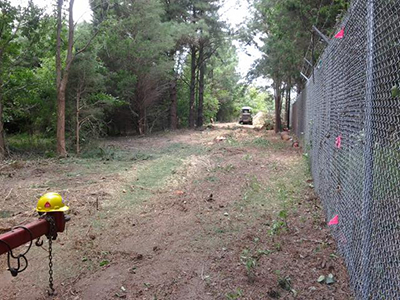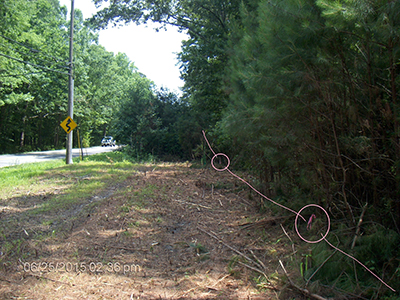October 2015 Vol. 70 No. 10
Features
Utility Infrastructure Challenges In The Urban Forest

7 Steps to Utility Easement Maintenance Program Management
 The city of Virginia Beach, VA, Public Utilities infrastructure and its urban forest provide sustainable services to our citizens. The utilities infrastructure provides purified water and sanitary sewer services to a majority of our citizens in Virginia Beach.
The city of Virginia Beach, VA, Public Utilities infrastructure and its urban forest provide sustainable services to our citizens. The utilities infrastructure provides purified water and sanitary sewer services to a majority of our citizens in Virginia Beach.
Our urban forest with a tree canopy of 36 percent provides social, economic, aesthetic and environmental benefits to the city. In order to maintain our public utilities infrastructure, we must maintain our utility easements to ensure that above- and below-ground pipelines are functional.
Within our utility easements the urban forest prospers. Public Utilities would like to clear the entire width of utility easements to provide maximum utilization of the easement. This activity would reduce and impair the urban forest. The Urban Forest Management Plan goal is to increase tree canopy to 40 percent or more. In order to achieve the dual goals of utility easement maintenance and urban forest management, staff members from different departments and professional disciplines must agree on a plan that is best for the city of Virginia Beach.
The current plan is for members of Public Utilities and Parks and Recreation to review utility easements in the field and determine what should be removed to access, operate and maintain the Public Utilities infrastructure. For every tree that is removed, another tree is planted and funded by Public Utilities. The process is subjective, but it minimizes the probability that utility professionals might inadvertently remove critical trees in the urban forest for easement maintenance.
The program involved seven primary steps to resolve and formulate a program for Virginia Beach.
Prioritize areas for easement clearance; reviewed aerial crossing from various mapping programs – About 50 miles of our utilities infrastructure is located in easements. We decided to focus on locations that would have the highest environmental impact if an emergency rupture were to occur. The Chesapeake Bay is on the northern shores of Virginia Beach and the majority of our rivers and waterways in our urban core flow to the Chesapeake Bay. After narrowing our initial scope to the Chesapeake Bay Preservation area, we had our consultant and staff members review GIS maps with aerial photos that had sewer force mains that were in utility easements. They selected ten locations where the urban forest thrived on top of our pipelines.
 We decided to put “boots on the ground” to see if the satellite imagery that was one year or older was still in the same condition. Going on site allowed us to understand the terrain and other difficulties with invasive plants such as phragmites and bamboo. We were also able to determine the caliper and age of the trees. Maps in GIS or construction as-built are not always accurate. Witness posts that were installed years ago were also damaged, removed or surrounded by vegetation.
We decided to put “boots on the ground” to see if the satellite imagery that was one year or older was still in the same condition. Going on site allowed us to understand the terrain and other difficulties with invasive plants such as phragmites and bamboo. We were also able to determine the caliper and age of the trees. Maps in GIS or construction as-built are not always accurate. Witness posts that were installed years ago were also damaged, removed or surrounded by vegetation.
Survey easements and mark easement boundaries and pipelines; post or repost utility pipelines – Surveyors accurately determined the easement boundaries and located the underground pipelines. Utilizing a utility locator was difficult because they were unable to hookup there locating equipment to an above ground asset. Surveyors are able to determine if the pipelines even have a utility easement and if the pipelines were installed in the easement. Some pipelines
may have not been installed or constructed at the edge of the easement which can make rehabilitation work more challenging.
Research plats, property deeds at the city/county courthouse and construction as-built – GIS maps and property deeds assist in communicating with property owners the existence of utility easements. Most residential homeowners are so excited to purchase the property they do not take the required time to properly review the survey of the property they plan to purchase. Some states utilize the principle of caveat emptor, “let the buyer beware” for the sale of real property. The buyer is responsible and held accountable for all covenants that run with the property. Many utilities do not utilize their easement unless there is an emergency.
Any open land is fair game for encroachment. Some property owners state that if they encroach and the utility did nothing for two decades or more, they can continue to encroach. The deed has the language about the purpose and utility company’s rights and responsibilities to maintain the utility easement.
Communicate with property owners about underground utilities in a utility easement on their properties and encroachments (sheds, fences, etc.) – If time is available, communicate with all homeowners that are affected by the utility easement to explain the purpose and goals of the utility easement program. Town hall meetings, newspaper ads or utility websites can be utilized for any planned projects in the neighborhood. The utility must also communicate with other municipal departments, city council representatives and civic league representatives.
Certified arborist reviews and designate trees for removal within the utility easement. Develop mitigation plan for sustainability – A certified arborist has the knowledge, skills and abilities to determine which trees need to be removed and how to properly elevate trees that have entered the utility easement. A mitigation plan should also be negotiated. Trees increase property value in neighborhoods and provide numerous environmental benefits. Developing a positive relationship with environmental groups will assist in maintaining utility easements and assist in funding sustainable projects.
Maintenance contract for mowing site at least twice a year – If you live in a region where there are four seasons, a mowing in early summer and late fall will assist utility operators to access the utility pipeline. An area with mild winters may require more frequent mowing to minimize vegetation growth. Natural growth of vegetation assists in reducing rainfall runoff and erosion of soil. If aesthetics are a requirement, then consider seeding with the regional grass and determining a more frequent and neighbor-pleasing lawn mowing schedule.
Review utility easement at least every two years to search for encroachment and reposting utility markers if damaged by property owners or landscapers – someone in the utility should be responsible for continuous monitoring of the easements on a routine cycle. Overtime landscapers will hit the post with riding mowers and damage the post. Someone can remove it from their property for various reasons. Quality assurance checks via walking, satellite feeds or unmanned aerial vehicles (UAV) should be performed to ensure neighbors have not encroached and the landscapers properly maintain the easement as contracted.
ABOUT THE AUTHOR: Daren Williams monitors, analyzes and distributes monthly Maintenance Operations Management (MOM) Performance Measures and goals to the city of Virginia Beach, Department of Public Utilities, Operations Division, Wastewater Collections and Sewer Pump Station Bureaus, so they can review their monthly progress. He assists as an operations and maintenance engineer to operate and maintain 1,500 miles of gravity sewer and 180 miles of force main, and as a weekend standby engineer for water and sewer infrastructure.
The Utility Easement Maintenance Program is a program in the Consent Decree the city of Virginia Beach has agreed to with the Virginia Department of Environmental Quality (DEQ). He is an Engineer III for the City of Virginia Beach, Department of Public Utilities, Operations and Maintenance Division (2008 – present) and Assistant Professor of Industrial Engineering Technology at Tidewater Community College (2013 – present). He is also a NASSCO PACP, MACP and LACP Instructor. Previously he was a Surface Warfare Officer in the U.S. Navy specializing in electronic and nuclear reactor preventive maintenance (2002 – 2007).
Williams is a registered professional engineer in the Commonwealth of Virginia. He earned a Bachelor of Science in Ocean Engineering from the United States Naval Academy in 2002. He was awarded a Master of Engineering Management from Old Dominion University in 2007.




Comments